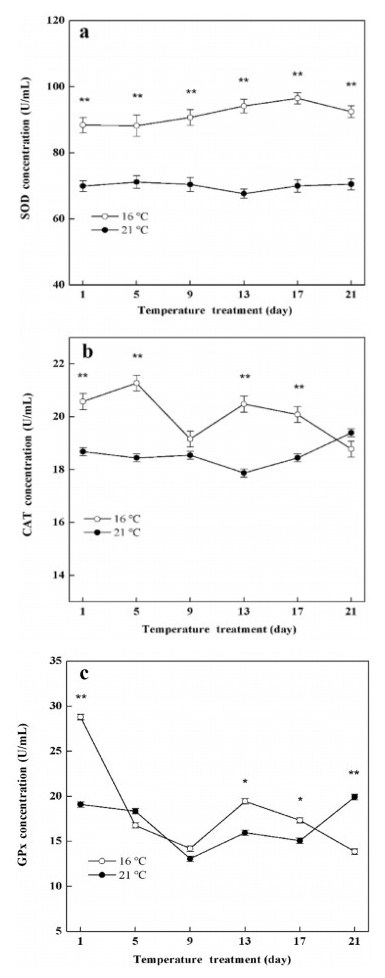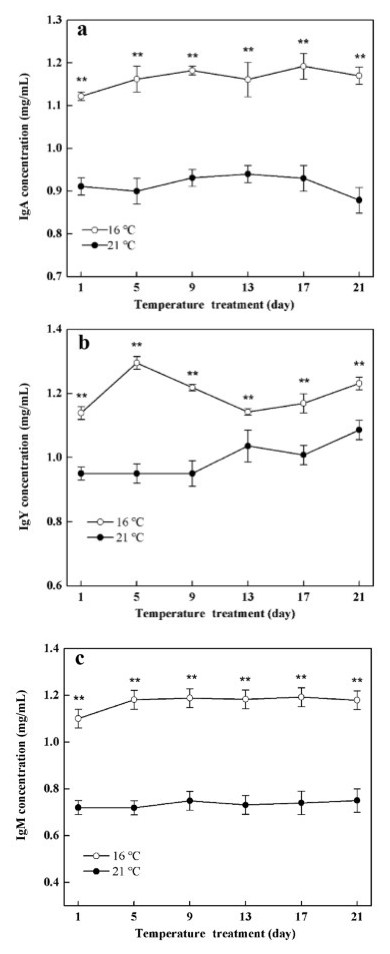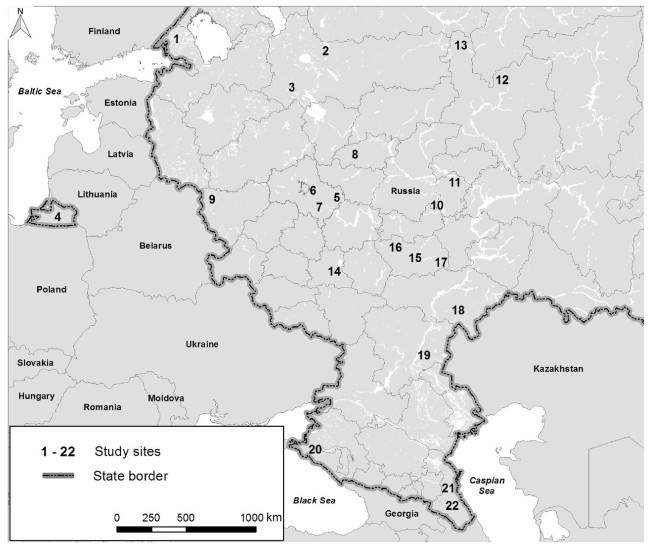Afton AD, Anderson MG. Declining scaup populations: a retrospective analysis of long-term population and harvest survey data. J Wildlife Manage. 2001;65:781-96.
|
|
Andreev BN. Birds of Vilyui basin. Yakutsk: Book Press; 1987 (in Russian).
|
|
Antonov AI, Parilov MP. Assessment of recent status of protected birds in the east of Amurskaya Oblast. Amurian Zool Mag. 2009;1:270-4 (in Russian).
|
|
Azarov VI. Resources of waterfowl in Tobol-Ishim forest-steppe, their conservation and use. PhD Thesis. Moscow: Moscow University; 1991 (in Russian).
|
Biodiversity Centre of Japan. Survey of waterbirds. Biodiversity Centre of Japan, Tokyo. 2019. . Accessed 26 Sep 2019 (in Japanese).
|
BirdLife International. European red list of birds. Luxembourg: Office for Official Publications of the European Communities; 2015.
|
|
Bukreev SA, Chernobay VF. Data on Anseriformes of the Volgograd Sarpa. Casarca. 2011;14:223-39 (in Russian).
|
|
Chernichko II, Kostyushin VA. Retrospective review of results of the ornithological monitoring in wetlands: Molochnyi Liman. Results Regional Ornithol Monitoring. 2015;9:68 (in Russian).
|
|
Chudnenko DE. Dynamics of bird fauna and populations in peat extractions on a sample of Sakhtysh-Rubskoye area (Ivanovo Region, Russia). In: Population dynamics of birds in terrestrial landscapes. Proceedings of the Russian Scientific Conference ZBS MSU March 17-21 2017. Moscow: KMK Scientific Press; 2017. p. 268-76 (in Russian).
|
|
Cramp S, Simmons KEL. Handbook of the birds of Europe, the Middle East and North Africa. The birds of the Western Palearctic, vol. 1. Oxford: University Press; 1977.
|
|
Degtyarev AG. Game birds of the Republic of Sakha (Yakutia). Yakutsk: Yakutsk Branch of State Publishing House of SB RAS; 2004 (in Russian).
|
|
Degtyarev AG. Waterfowl and waterbirds in the conditions of cryo-arid plain. Novosibirsk: Nauka; 2007 (in Russian).
|
|
Elsukov SV. Monitoring of waterfowl of Lake Blagodatnoye in the period of spring and autumn migrations. In: Potichina EV, editor. Results of conservation and study of nature complexes of Sikhote-Alin'. Vladivostok: Primpoligrafcombinat; 2005. p. 173-180 (in Russian).
|
|
Elsukov SV. Birds of the North-East Primorie: non-Passeriformes. Vladivostok: Dal'nauka; 2013 (in Russian).
|
|
FAO/EBRD. Russian Federation: a review of the fishery sector. New York: UN Food and Agriculture Organisation/European Bank for Reconstruction and Development Cooperation Programme Report N12; 2008.
|
|
Fedyushin AV, Dolbik MS. Birds of Belarus. Minsk: Science and technology; 1967 (in Russian).
|
|
Fefelov IV, Shinkarenko AV, Podkovyrov VA. Trend of the duck populations in Selenga Delta. Russ Ornithol Mag. 1995;1(2):45-53 (in Russian).
|
|
Fefelov IV, Voronova SG, Povarintsev AI. Numbers and survival of duck broods in the mouth of river Irkut in the last decade. Baikal Zool Mag. 2009;1:94-9 (in Russian).
|
Fox AD, Caizergues A, Banik MV, Dvorak M, Ellermaa M, Folliot B, et al. Recent changes in the abundance of breeding common pochard Aythya ferina in Europe. Wildfowl. 2016;66:22-40.
|
Fox AD, Balsby T, Jorgensen H, Lauridsen T, Jeppensen E, Sondergaard M, et al. Effects of lake restoration on breeding abundance of globally declining Common Pochard ( Aythya ferina). Hydrobiologia. 2019;830:33-44.
|
|
Frolov VV. Birds of Penza Region and adjacent territories. Vol. 1. Non-passeriformes. Penza: Penza University Press; 2017 (in Russian).
|
|
Gerasimov NN, Gerasimov YN. Investigations of migrations of waterfowl and waterbirds in Kamchatka. In: Savelieva AP, Seredkina IV, editors. Ranges, migrations and other movements of wildlife. Materials of the International science and applied conference. Vladivostok: OOO Reja; 2014. p. 52-61 (in Russian).
|
|
Gerasimov YN, Gerasimov NN. Birds of Elovka River. In: Artjukhin YB, Gerasimov YN, editors. Biology and conservation of the birds of Kamchatka. No. 8 Moscow: Wildlife Conservation Center Press; 2008. p. 38-64 (in Russian).
|
|
Glushchenko YN, Bocharnikov VN, Mrikot KN, Korobov DV. Centuries dynamics of numbers of Anseriformes in Lake Khanka Lowland. In: Bukreev SA, editor. Inventory, monitoring and conservation of IBAs in Russia. No. 5 Moscow: Russian Bird Conservation Union; 2005. p. 19-36 (in Russian).
|
|
Glushchenko YN, Shibnev YN, Volkovskaya-Kurdjukova EA. Birds. In: Nazarenko AA, editor. Vertebrates of Zapovednik Khankajskiy and Lake Khanka Lowland. Vladivostok: GPBZ Khankaisky Press; 2006. p. 77-233 (in Russian).
|
|
Glushchenko YN, Nechaev VA, Red'kin YA. Birds of Primorski Krai: brief faunistical review. Moscow: KMK Press; 2016 (in Russian).
|
|
Glushenkov OV, Isakov GN, Osmelkin EV. Cadastre assessment of condition of gull colonies in Chuvash Republic. Ecol Bull Chuvash Republic. 2007;57:29-44 (in Russian).
|
|
Grishanov G, Švažas S. The Neman River delta—internationally important area for migratory wildfowl species. Vilnius: Akstis; 2013 (in Russian).
|
|
Iovchenko NP. Ecosystems of the nature reserve "Lakes Rakovye": history and present state. Saint-Petersburg: Saint-Petersburg University Press; 2012 (in Russian).
|
|
Isakov YA, Ptushenko ES. Order Anseriformes. In: Dementiev GP, Gladkov NA, editors. Birds of the Soviet Union, vol. IV. Moscow: Sovetskaya nauka; 1952. p. 247-635 (in Russian).
|
|
Ivanauskas T. Birds of Lithuania Wildfowl, vol. 2. Vilnius: State Publishers of Scientific Literature; 1959 (in Lithuanian).
|
Kalela O. Changes in geographic ranges in the avifauna of northern and central Europe in relation to recent changes in climate. Bird Banding. 1949;20:77-103.
|
Kalinina L, Zelenskaya I. Current state and problems of commercial fish-farming development in Russia. SHS Web Conf. 2018;55:01008. .
|
|
Kear J. Ducks, Geese and Swans. Bird families of the World. Oxford: University Press; 2005.
|
|
Khrabry VM. Game animals of Leningrad Region. Saint Petersburg: Saint Petersburg University Press; 2016 (in Russian).
|
|
Klimov SM, Sarychev VS, Melnikov MV, Zemlyanukhin AI. Bird fauna of the Upper Don Basin. Non-passeriformes. Lipetsk: LGPU; 2004 (in Russian).
|
|
Komdeur J, Bertelsen J. Manual for aeroplane and ship surveys of waterfowl and seabirds. Slimbridge: International Waterbird and Wetlands Research Bureau Special Publication 19 IWRB; 1992.
|
|
Koskimies P, Väisänen RA. Monitoring bird populations: a manual of methods applied in Finland. Helsinki: University of Helsinki, Zoological Museum; 1991.
|
|
Krivenko VG, Vinogradov VG. Birds of the water environment and rhythms of climate of the Northern Eurasia. Moscow: Nauka; 2008 (in Russian).
|
|
Lobkov EG. Nesting birds of Kamchatka. Vladivostok: Far East Science Centre, USSR Academy of Sciences; 1986 (in Russian).
|
|
Lokhman YV, Gozhko AA. Counts of waterfowl, shorebirds and seabirds in the Krasnodar Region in November 2017. Russ J Ornithol. 2017;28:4591-7 (in Russian).
|
|
Lysenko V. The fauna of Ukraine Birds. Vol. 5. Anseriformes. Kiev: Naukova Dumka; 1991 (in Russian).
|
|
Malchevsky AS, Pukinsky YB. Birds of Leningrad Region and contiguous territories, vol. 1. Leningrad: University Press; 1983 (in Russian).
|
Melnikov YI, Melnikova NI, Pronkevich VV. Materials on the waterfowl fauna in the mouth of river Irkut. Ornithologia. 2003;30:32-7 (in Russian).
|
|
Merikallio E. Einwanderungsgeschichte der Vogelfauna des Ayrapaanjarvi-Sees in Suomi Finland Istmus Karelicus. Berlin: Proceedings of the VI International Ornithological Congress, Berlin; 1929. p. 484-93 (in German)
|
|
Miklin NA, Shitikov DA, Babushkin MV. Square 37VDH4, Vologda and Arkhangelsk regions. In: Voltzit OV, Kalyakin MV, editors. The fauna and abundance of European Russia Birds Annual report on the Programme "Birds of Moscow City and the Moscow Region". Moscow: Fiton Century Publications; 2013. p. 351-353 (in Russian).
|
|
Mikhantyev AI, Selivanova MA. Population dynamics of several species of ducks in the south of West Siberia (North Kulunda) related to hydrologic, climatic, and meteorological conditions. Casarca. 2016;19:67-80 (in Russian).
|
|
Mischenko AL. Value of fishponds of for bird fauna in the conditions of man-made landscape (on an example of Moscow Region). PhD Thesis. Moscow: Moscow State University. 1985 (in Russian).
|
|
Mischenko AL. Estimations of numbers and trends for birds of the European part of Russia ("Birds in Europe-II"). Moscow: Russian Bird Conservation Union; 2004.
|
|
Mischenko AL. Estimations of numbers and trends for birds of the European Russia ("European Red List of Birds"). Moscow: BirdsRussia; 2017.
|
|
Mischenko AL, Sukhanova OV. Fishponds as the main refuges of waterbirds in the Moscow Region. OMPO Newsl. 2006;26:47-50.
|
|
Mischenko AL, Sukhanova OV. Results of long-term monitoring of breeding ducks' numbers in Vinoradovo floodplain (Moscow oblast). Casarca. 2016a;19:31-48 (in Russian).
|
Mischenko AL, Sukhanova OV. Response of wader populations in the Vinogradovo Floodplain (Moscow Region, Russia) to changes in agricultural land use and spring flooding. Wader Study. 2016b;123:136-42.
|
|
Moskalev VA. Hunting on waterfowl in Leningrad oblast. Hunting, Peltry Quarry. 1977;56:3-10 (in Russian).
|
|
Mundkur T, Langendoen T, Watkins D. The Asian Waterbird Census 2008-2015: Results of coordinated counts in Asia and Australasia. Ede, The Netherlands: Wetlands International; 2017.
|
|
Nagy S, Flink S, Langendoen T. Waterbird trends 1988-2012: Results of trend analyses of data from the International Waterbird Census in the African-Eurasian Flyway. Ede, The Netherlands: Wetlands International; 2014.
|
|
Neifeldt IA. Review of the ornithological studies in Karelia. Proc Zool Inst Russ Acad Sci. 1970;47:67-110 (in Russian).
|
|
Numerov AD. Birds Aves Natural resources of Voronezh Region Vertebrate Animals Cadaster. Voronezh: Biomik; 1996 (in Russian).
|
Olney PJS. The food and feeding-habits of the Pochard, Aythya ferina. Biol Conserv. 1968;1:71-6.
|
|
Ostrovsky OA, Natykanets VV. Monitoring of waterfowl. In: Sushchenya LM, Semenchenko VP, editors. Monitoring of fauna of Belarus basic principles and results. Minsk: Belarus Research Centre of Ecology; 2005. p. 127-35 (in Russian).
|
|
Ostrovsky OA, Natykanets VV, Zhuravlev DV. Changes in species composition and abundance of waterbirds of Lake Osveyskoe during the last 30 years. In: Proceedings of the 3rd International Conference on Protected areas of NW Belarus. Vitebsk: Vitebsk University; 2009. p. 66‒7 (in Russian).
|
|
Petkov N, Hughes B, Gallo-Orsi U. Ferruginous Duck: from research to conservation. Sofia, Bulgaria: Birdlife International-RSPB-TWSG; 2013.
|
|
Polivanova NN. Birds of Lake Khanka. Part 1. Vladivostok: DVNC of Academy of Science USSR Press; 1971 (in Russian).
|
|
Polyakov GI. The ornithological fauna of Moscow Province. Materials to knowledge of fauna and flora of Russian Empire. Dept Zoo. 1910;10:1-211 (in Russian).
|
|
Ptushenko ES, Inozemtsev AA. Biology and economic value of the birds of Moscow Region and adjacent territories. Moscow: Moscow University Press; 1968 (in Russian).
|
|
Ryabitsev VK. Birds of Siberia. A field guide in two volumes, vol. 1. Moscow—Ekaterinburg: Armchair Scientist; 2014 (in Russian).
|
|
Ryazanova NE, Kravchuk MV. Changes of the areas of Sarpinskie Lakes in 2005-2016. In: Akhmetov IG, editor. Materials of the 3rd International Conference on Sciences on the Earth: yesterday, today, tomorrow. Saint Petersburg: Svoyo Isdatelstvo Press; 2017. p. 26-32 (in Russian).
|
|
Rusanov GM. Aerial monitoring of mass bird species the Volga avandelta (2006-2010). Ornithol Bull Kazakhstan Cent Asia. 2013;2:146-65 (in Russian).
|
|
Sarantseva EI. Structure and spatial distribution of bird communities in the valley ecosystems of small rivers in Low Volga Basin. PhD Thesis. Saratov: Saratov State University; 2003 (in Russian).
|
|
Sarychev VS, Batishchev DL. Avifauna of the Gryazinsky Fishponds. Bull Rare Plants Animals Lipetsk Region. 2012;5:60-88 (in Russian).
|
|
Serebryakov V, Vorobyev E, Gorban I, Davidenko I, Korzyukov A, Lugovoj A, et al. The status and number of certain waterbird species in Ukraine. Kiev: Fitosociocenter Press; 2003.
|
|
Shulpin LM. Commercial, hunting and predatory birds of Primorye. Vladivostok: Far Eastern branch of the USSR Academy of Sciences Press; 1936 (in Russian).
|
|
Sotnikov VN. Birds of Kirov Region and contiguous territories. Vol.1. Non-passerines. Part 1. Kirov: OOO Triada-S; 1999 (in Russian).
|
|
Stepanyan LS. Conspectus of ornithological fauna of Russia and neighbouring territories. Moscow: Nauka; 2003 (in Russian).
|
|
Sukhanova OV. Nesting ecology of the Tufted Duck Aythya fuligula and the Pochard Aythya ferina in Central Russia. Gibier Faune Sauvage. 1996;13:709-22.
|
|
Syroechkovskiy EE. Field guide of Anseriformes of Russia. Moscow: Zoological Museum of Moscow State University; 2011 (in Russian).
|
|
Švažas S, Drobelis E, Balciauskas L, Raudonikis L. Important wetlands in Lithuania. Vilnius: Akstis; 1999.
|
|
Švažas S, Kozulin A. Waterbirds of large fishponds of Belarus and Lithuania. Vilnius: Lithuanian Institute of Ecology; 2002.
|
|
Takahashi T. On the birds breeding near lake Taraika, S Sakhalin. Tori. 1942;11:370-89.
|
|
Tarasov VV. Recent condition of recourses of Anseriformes in Tobol-Ishim forest-steppe. In: Popovkina AB, editor. Abstracts of International Conference "Anatidae of North Eurasia: study, protection and wise use". Salekhard: Working group on geese of Northern Eurasia; 2015. p. 89-90 (in Russian).
|
|
Tischler F. Die Vögel Ostpreußens und seiner Nachbargebiete. Königsberg und Berlin: Bd.; 1941 1-2 (in German).
|
|
Tilba PA, Mnatsekanov RA. Avifauna of Priazovsky Nature Reserve. Acta Sochi National Park. 2014;6:60-120 (in Russian).
|
|
Tsyndzhapova ND. Seasonal dynamics of bird population in the wetland complex of city Irkutsk. Bull State Agr Acad Buryatia. 2009;3:138-42 (in Russian).
|
U.S. Fish and Wildlife Service. Waterfowl population status, 2019. Washington, DC USA: U.S. Department of the Interior; 2019. .
|
Väänänen VM. Predation risk associated with nesting in gull colonies by two Aythya species: observations and an experimental test. J Avian Biol. 2000;31:31-5.
|
Väänänen VM, Pöysä H, Runko P. Nest and brood stage association between ducks and small colonial gulls in boreal wetlands. Ornis Fennica. 2016;93:47-544.
|
|
Viksne J. The birds of Lake Engure. Riga: Jana seta Press; 1997.
|
|
Viksne J, Švažas S, Czajkowski A, Janaus M, Mischenko A, Kozulin A, et al. Atlas of Duck Populations in Eastern Europe. Vilnius: Akstis; 2010.
|
Voropay NN, Ryazanova AA. Atmospheric droughts in Southern Siberia in the late 20th and early 21st centuries. IOP Conf Ser Earth Environ Sci. 2018;211:012062.
|
|
Vorobiev KA. Birds of Ussurijskiy Kraj. Moscow: USSR Academy of Sciences Press; 1954 (in Russian).
|
|
Vorobiev KA. Birds of Yakutia. Moscow: USSR Academy of Sciences Press; 1968 (in Russian).
|
|
Voronov LN, Glushenkov OV, Isakov GN, Osmelkin EV, Yakovlev AA, Yakovlev VA. Birds of Chuvashia Non-passeriformes, vol. 1. Cheboksary: Chuvash Press; 2016 (in Russian).
|
|
Voronov VG, Voronov GA, Neverova TI, Eremin YP, Voronov GV, Zdorikov AI. Birds of the Lake Nevskoye (Sakhalin Island). Juzhno-Sakhalinsk: SakhKNII; 1983 (in Russian).
|
|
Vyazovich V. Ducks of Belarus. Minsk: Vyshejshaya Shkola Press; 1973 (in Russian).
|
Wang X, Barter M, Cao L, Jinyu L, Fox AD. Serious contractions in wintering range and decline in abundance of Baer's Pochard Aythya baeri. Bird Conserv Int. 2012;22:121-7.
|
Wetlands International. Flyway trend analyses based on data from the African-Eurasian Waterbird Census from the period of 1967-2015. Ede, The Netherlands: Wetlands International. 2017. . Accessed 26 Jun 2020.
|
Wetlands International. Waterbird population estimates. 2019. . Accessed 10 Sep 2019.
|
|
Zavjalov EV, Shlyakhtin GV, Kapranova TA. Waterfowl and waterbirds of Saratov Region (Gaviformes, Podicipediformes, Pelicaniformes, Ciconiiformes, Phoenicopteriformes, Anseriformes). Berkut: Ukr Ornithol Mag. 1997;6:3-18 (in Russian).
|
|
Zavjalov EV, Shlyakhtin GV, Tabachishin VG, Yakushev NN, Khrustov IA. Birds of the northern part of Low Volga Basin. Book 1. Saratov: Saratov University Press; 2005 (in Russian).
|
|
Zhukov VS. Birds of Middle Siberia forest-steppe. Novosibirsk: Nauka; 2006 (in Russian).
|
|
Zubakin VA, Morozov VV, Kharitonov SP, Leonovich VV, Mischenko AL. The birds of the Moscow-river meadowland near Vinogradovo, Moscow Region. In: Flint VE, Tomkovich PS, editors. Birds of reclaiming territories. Moscow: Moscow University Press; 1998. p. 126-167 (in Russian).
|



 DownLoad:
DownLoad:








 Email Alerts
Email Alerts RSS Feeds
RSS Feeds